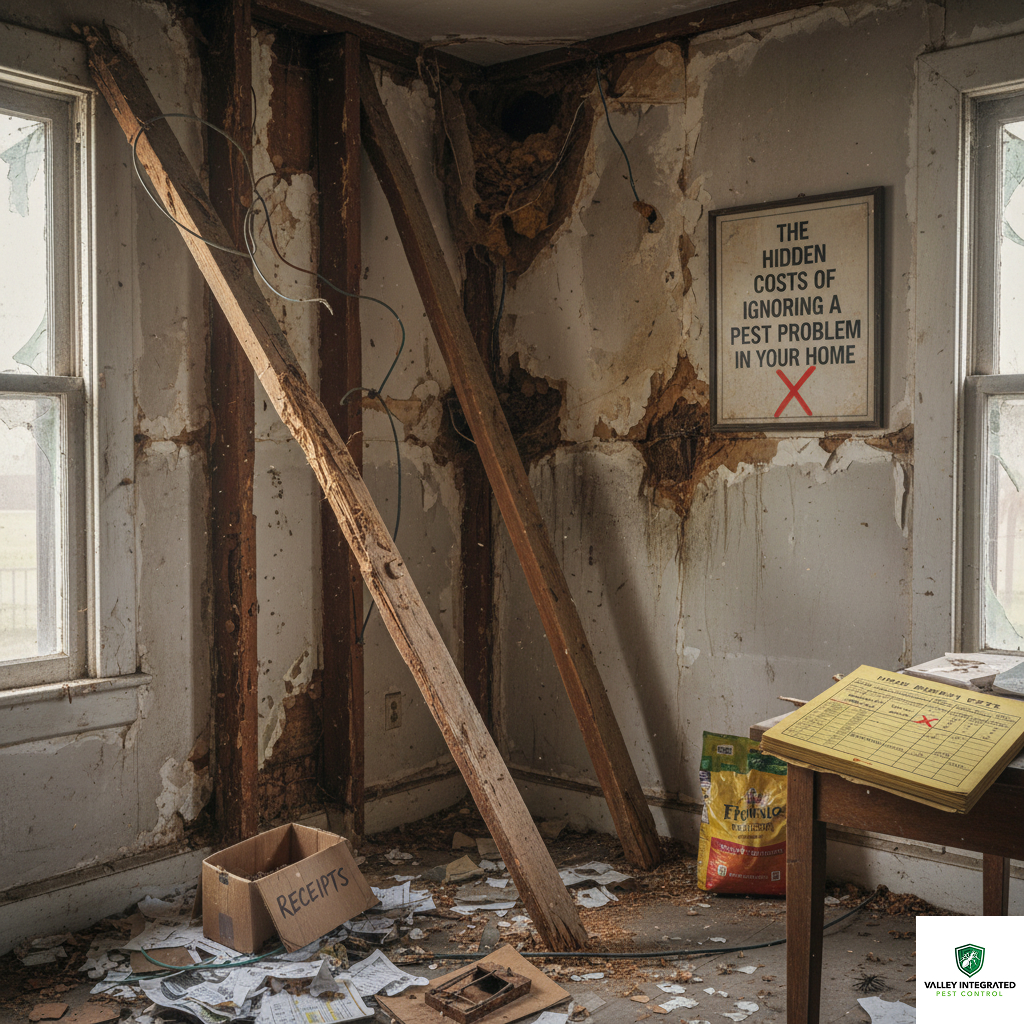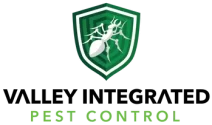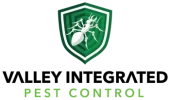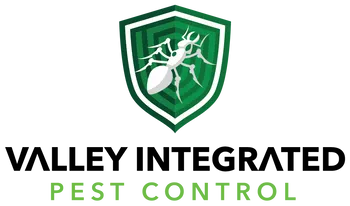Ignoring a pest problem is a costly mistake because the pests you see are often just the first visible symptom of deeper, hidden issues. Underlying problems like structural moisture damage can silently degrade your home’s value, compromise its safety, and lead to repair bills that far exceed the cost of professional pest management.
The iceberg effect: why pests are just the tip of the problem
Discovering a line of ants in the kitchen or hearing a scurrying sound in the walls can be unsettling. The immediate impulse for many homeowners is to set a trap or spray a store-bought chemical, believing the problem is solved once the visible intruders are gone. This approach, however, fundamentally misunderstands the nature of an infestation. Pests are not the root cause of the problem; they are a clear and present symptom that your home is providing the three things they need to thrive: food, water, and shelter. Their presence is a warning sign that your home has a vulnerability that needs to be addressed before it escalates.

The unseen enemy: moisture as a pest magnet
One of the most significant yet overlooked vulnerabilities in any home is excess moisture. A damp basement, a slow leak under a sink, or poor ventilation in a crawl space creates an environment where pests can flourish. High humidity does more than just make a home uncomfortable; it saturates building materials and fosters the growth of mold and mildew, which serve as a food source for smaller insects. Critically, The US Environmental Protection Agency (EPA) recommends that indoor moisture levels do not exceed 60%, and ideally fall between 30 and 50%. When humidity levels consistently exceed this threshold, you are essentially rolling out the welcome mat for a host of unwelcome guests.
The structural saboteurs: termites and carpenter ants
Moisture doesn’t just attract nuisance pests; it invites true destroyers into your home. As noted by entomology experts, two pests that exploit moisture in wood and can cause additional structural problems are carpenter ants and termites. While they operate differently, the result is the same: the degradation of your home’s wooden framework. Termites consume cellulose, literally eating their way through support beams, floor joists, and wall studs. Carpenter ants, on the other hand, excavate damp wood to build their nests. In both cases, the wood is hollowed out and weakened, silently compromising the structural integrity of your property until the damage becomes severe and costly to repair.
Financial fallout: calculating the true cost of neglect
Related: How much should I expect to pay for pest control in Fresno?
Many people wonder, “Is pest control a waste of money?” The answer becomes clear when you compare the cost of preventative management with the catastrophic expenses of inaction. The financial damage from a neglected pest problem extends far beyond the pests themselves and can be broken down into several categories.
- Structural Repairs: This is often the most significant expense. Replacing termite-damaged support beams, subfloors, or roof trusses can cost tens of thousands of dollars. Repairing water damage that attracted pests in the first place adds another layer of cost.
- Property Devaluation: A history of significant pest infestations, especially termites, must often be disclosed during a home sale. This can lower your property’s market value and deter potential buyers. A failed home inspection due to pest activity or damage can derail a sale entirely.
- Health-Related Expenses: Pests are not just a structural threat; they are a health hazard. Cockroach droppings and shed skins are known triggers for asthma and allergies, particularly in children. Rodents can transmit diseases like Hantavirus and Salmonella through their urine and feces, contaminating surfaces and stored food.
- Damaged Goods: From rodents chewing through electrical wiring (a major fire hazard) to moths destroying valuable clothing and pantry pests ruining hundreds of dollars in groceries, the cost of replacing damaged personal property can add up quickly.
Common household intruders and their hidden agendas
While any pest can become a problem, certain species are notorious for the level of difficulty and damage they bring. Understanding these common culprits helps illustrate why professional intervention is so critical. Each pest signals a different type of underlying issue that requires a specific strategy to resolve.
What is the number one pest problem?
While it can vary by region, rodents (mice and rats) are arguably the number one pest problem for homeowners nationwide due to their destructive potential and health risks. A mouse can squeeze through a hole the size of a dime, making entry into homes incredibly easy. Once inside, they reproduce at an astonishing rate. Their constant need to gnaw can lead them to chew through drywall, insulation, plumbing lines, and, most dangerously, electrical wiring. Their ability to contaminate food preparation areas with pathogens makes them a serious threat to your family’s well-being. Effective control isn’t just about setting traps; it involves a meticulous inspection to seal every potential entry point. For example, experts advise that for rodent-proofing vents in basements and crawl spaces, it is recommended to use hardware cloth with quarter (1/4) inch openings.
What is the hardest pest to get rid of in the house?
When it comes to sheer resilience and difficulty to eradicate, few pests can compete with bed bugs and German cockroaches. Bed bugs are masters of hiding, are notoriously resistant to many pesticides, and can survive for months without a blood meal. Their elimination almost always requires specialized, professional-grade treatments. Similarly, German cockroaches reproduce faster than any other common cockroach species. They are adept at finding refuge in the smallest cracks and crevices within walls, behind appliances, and inside electronics, making them a persistent challenge that rarely succumbs to DIY methods.
A world without defense: the consequences of no pest control
Considering “What would happen if we had no pest control?” paints a grim picture. On an individual level, homes would face accelerated decay and become unsafe living environments. On a societal scale, the consequences would be dire. Food supplies would be subject to massive contamination and spoilage, both in homes and throughout the agricultural supply chain. The spread of pest-borne diseases would increase, placing a significant strain on public health systems. Our infrastructure, from homes to public utilities, would be under constant attack from wood-destroying insects and gnawing rodents. Pest control is not a luxury; it is a vital service that protects public health, preserves property, and ensures our food is safe to eat.
The professional advantage: why integrated pest management is the solution
The most effective, responsible, and long-lasting approach to pest control is a strategy known as Integrated Pest Management (IPM). This is not simply about applying chemicals; it is a holistic and intelligent methodology that addresses both the symptom (the pests) and the root cause (the conditions that attract them). At its core, IPM is a partnership between you and a pest control professional to make your home less hospitable to pests.
- Inspection: A trained professional will conduct a thorough inspection of your property to identify the specific pests present and, more importantly, to locate the entry points, moisture sources, and food supplies that are sustaining them.
- Identification: Correctly identifying the pest is crucial. The biology and habits of a carpenter ant are vastly different from those of a termite, requiring completely different treatment and prevention strategies.
- Exclusion and Prevention: This is the most critical step for long-term success. It involves sealing cracks and crevices, installing proper screening on vents, fixing leaky pipes, improving drainage, and advising on sanitation practices. By removing the conditions that attract pests, you create a powerful, lasting defense.
- Targeted Treatment: When treatment is necessary, an IPM approach prioritizes using the most effective and lowest-risk options. This means targeted applications in precise locations rather than indiscriminate spraying, ensuring the safety of your family and pets.
- Monitoring: Professional pest control is an ongoing process. Regular monitoring ensures that the implemented solutions are working and allows for quick adjustments if new threats emerge.
Conclusion: protecting your greatest investment
Your home is more than just a building; it is your family’s sanctuary and your most significant financial asset. Viewing pest control as an unnecessary expense is a short-sighted perspective that ignores the profound and costly risks of neglect. The pests you see are a direct message that your home’s defenses have been breached. By investing in professional pest management, you are not just eliminating an annoyance—you are protecting your home’s structural integrity, your family’s health, and your financial future.
For homeowners in the Fresno, CA area, taking proactive steps is key. The licensed and insured professionals at Valley Integrated Pest Control provide tailored, effective pest management solutions. We don’t just treat the pests you see; we identify and help you solve the underlying problems that invite them into your home. Contact us today for a comprehensive inspection and protect the health, safety, and value of your greatest investment.






